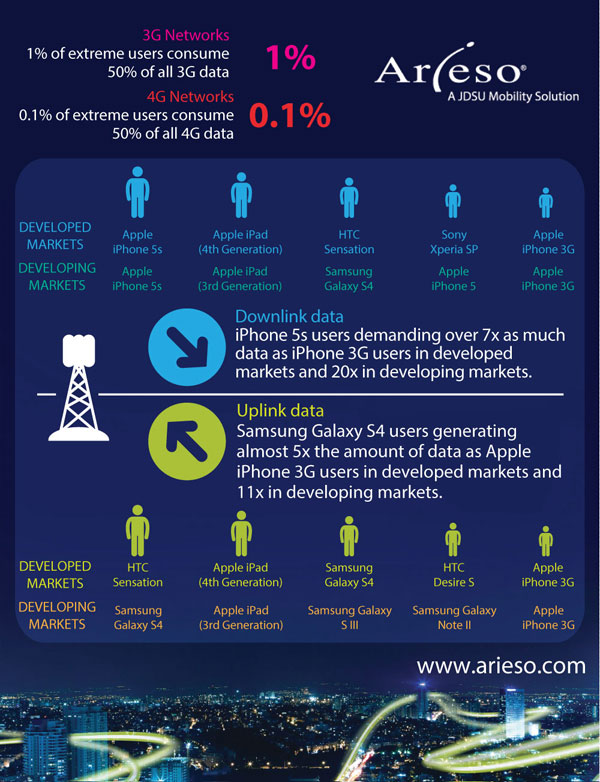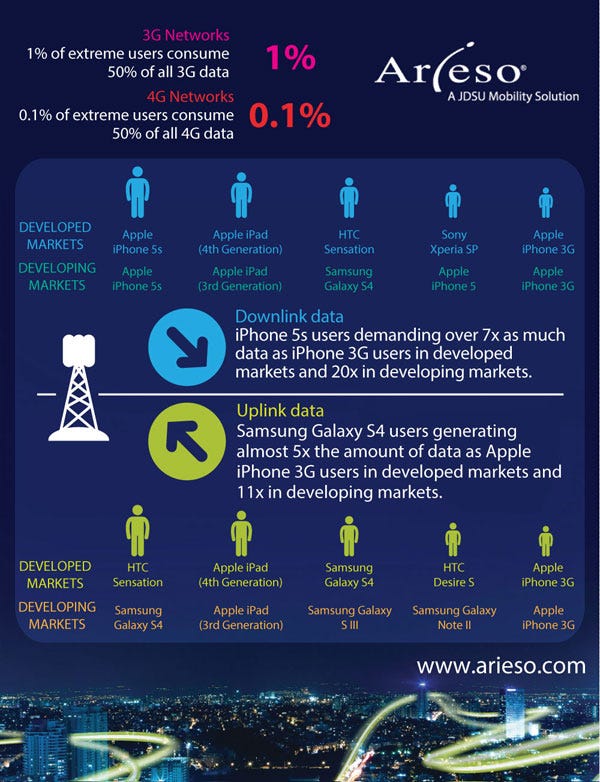Heavy users of mobile data services are ten times more extreme in the LTE era than on 3G, with just 0.1 per cent of mobile users in both developed and emerging markets consuming over half the LTE downlink data. This compares to one per cent of 3G users consuming half the downlink data.
January 23, 2014

Heavy users of mobile data services are ten times more extreme in the LTE era than on 3G, with just 0.1 per cent of mobile users in both developed and emerging markets consuming over half the LTE downlink data. This compares to one per cent of 3G users consuming half the downlink data.
The findings come from an annual survey carried out by Arieso, now owned by network optimisation firm JDSU. According to Michael Flanagan, CTO for Mobility at JDSU and author of the report, the data supports a real argument for the ‘surgical’ implementation of a small number of small cells in order to cater to these heavy users and offload them from the cellular network.
“Mobility is getting personal again,” said Flanagan. “Operators need to be more attentive to the individual even if it means installing a small cell somewhere just to cater to that one regular extreme user.”
What was interesting about this finding was that in an age where unlimited cellular data access is increasingly hard to come by – many carriers have ceased unlimited offerings – that it’s still possible to be a heavy user.
But with iPhone 5S users topping the charts as the ‘hungriest’ users in both the developed and emerging markets monitored, the suggestion is that those that can afford the most expensive handsets can also afford to spend on cellular data consumption. This was backed up in second place where the fourth and third generation iPads dominated in developed and emerging markets respectively. Apple’s ‘budget’ phone, the iPhone 5c, didn’t feature in the top five, coming in at six and seventh place in mature and maturing markets.
According to Arieso, iPhone 5s users demand seven times as much data as the study’s benchmark device – the iPhone 3G – in developed markets, and twenty times as much data in developing markets. While iPhone 5s users demand 20 per cent more data than iPhone 5 users, who were the most demanding last year, in developed markets, and 50 per cent more data in developing markets.
The 10th annual LTE World Summit, the premier 4G event for the telecoms industry, is taking place on the 23rd-26th June 2014, at the Amsterdam RAI, Netherlands. Click here to download a brochure for the event.
“Developing markets saw higher data consumption by flagship smartphone users, relative to the iPhone 3G standard. This appears to be driven by two factors. First, the older iPhone 3G has relatively lower data consumption per user in developing markets. Second, the absence of other high-volume data devices, such as data cards and tablets, means that users will consume more data via flagship smartphones,” said Flanagan.
Interestingly, it was the Samsung Galaxy S4 users who tax the network most on the uplink, generating five times as much data as iPhone 3G users in developed markets, and eleven times as much data in developing markets. The Galaxy S4 was just beaten out by the HTC Sensation in mature markets as the heaviest on the uplink, while the iPad third and fourth generations held the same position as for the downlink.
“The faster the speeds that mobile operators provide, the more consumers swallow it up and demand more,” said Flanagan. “One would expect a honeymoon period in which early adopters test their toys. But for 4G users to consistently exhibit behaviour ten times more extreme than 3G users well after launch constitutes a seismic shift in the data landscape. This has important ramifications for future network designs.”

About the Author(s)
You May Also Like








.png?width=300&auto=webp&quality=80&disable=upscale)


_1.jpg?width=300&auto=webp&quality=80&disable=upscale)


.png?width=800&auto=webp&quality=80&disable=upscale)